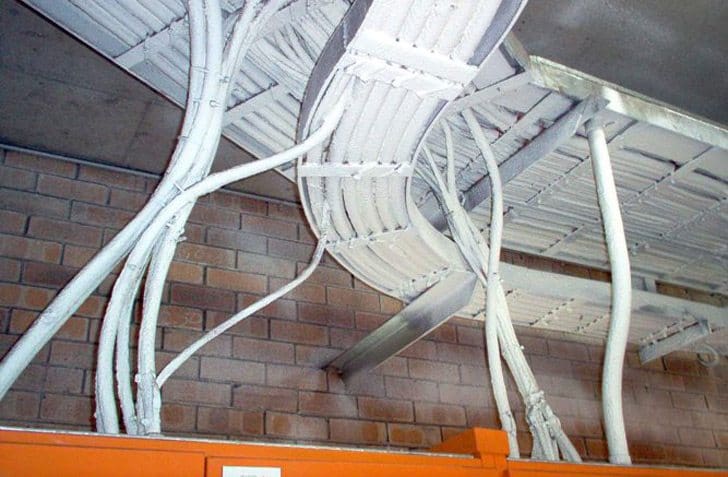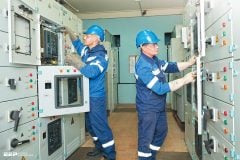
Standards relating to fire properties of cables
IEC, BS standards
This is an area of increasing public and legislative concern, and therefore of increasing interest to engineers. There have been major advances in the fire performance of cables in recent years, and table below lists some of the relevant standards.
| Standard | Description |
| IEC 60331 | Fire resisting characteristics of electric cables. |
| IEC 60332 | Tests on electric cables under fire conditions. Test methods and flame propagation of power and control/communication cables.Note the identical EN60332 and equivalent national standard BSEN60332 supersede EN50265 and BS 4066. |
| IEC 60754 | Test of gases evolved during combustion of electric cables. |
| IEC 61034 | Measurement of smoke density of cables burning under defined conditions. Identical EN61034 and national equivalent BSEN 61034 supersede EN50268 and BS7622. |
| BS 6387 | Performance requirements for cable required to maintain circuit integrity under fire conditions. |
| BS 6724 | Electric cables. Thermosetting insulated, armoured cables for voltages of 600/1000 V and 1900/3300 V, having low emission of smoke and corrosive gases when affected by fire. |
| BS 7211 | Electric cables. Thermosetting insulated, non-armoured cables for voltages up to and including 450/750 V, for electric power, lighting and internal wiring, and having low emission of smoke and corrosive gases when affected by fire. |
| BS 7835 | Specification for cables with cross-linked polyethylene or ethylene propylene rubber insulation for rated voltages from 3800/6600 V up to 19 000/33 000 V having low emission of smoke and corrosive gases when affected by fire. |
| EN 50267 | Common test methods for cables under fire conditions. Tests on gases evolved during combustion of materials from cables. Apparatus. BSEN50267 is identical and supersedes BS6425. Similarly French standard NF C 20-454 is superseded. |
Toxic and corrosive gases
It is recognized that conventional flame retardant cables having sheathing based upon PVC type materials evolve considerable quantities of halon acid gases such as hydrogen chloride upon burning.
Such materials are not therefore suitable for use in confined spaces where the public are likely to travel, and moreover the fire in the ENEL power station at La Spezia in 1967 showed that in certain circumstances PVC cables will burn completely and contribute to the spread of a fire.
Cables manufactured with such materials are known as ‘Low Smoke and Fume’ (LSF) and have acid gas evolution less than 0.5% in comparison to 25–30% for PVC compounds.
IEC 60754-1 specifies a method of determining the amount of halogen acid gas, other than hydrofluoric acid, evolved during combustion of halogen based compounds. The method essentially measures the existence of halogen acid greater than 0.5%, the accuracy limit for the test.
Therefore cables tested having less than the 0.5% limit are generally termed ‘zero halogen’ or ‘low smoke zero halogen’ (LS0H).
Smoke emission
Normal cable sheathing compounds also give off dense smoke when burned and this is of particular concern in underground transport system installations. The generation of large amounts of smoke obscures vision and reduces the ease with which the fire brigade is able to bring members of the public to safety in the event of a fire. LSF cables therefore play an important part in reducing this danger to a minimum.
London Underground Limited (LUL) have developed a test of practical significance which has been designed to measure the density of smoke emission from cables and it has now been adopted by British and IEC Standards. This defines the standard absorbance produced across the opposite faces of a test cubicle and is popularly known as the 3 m cube test.
Paris Metro (RATP) adopts the French Standard UTE C20-452 on smoke emission which determines under experimental conditions the specific optical density of smoke produced by burning material. This slightly different approach is generally known as the NBS smoke chamber test.
Oxygen index and temperature index
‘Oxygen index’ is the minimum concentration of oxygen in an oxygen/nitrogen mixture in which the material will burn. As air contains approximately 21% oxygen it is stated that a material with an oxygen index greater than about 26% will be self extinguishing. In general, a particular oxygen index value offers no guarantee of resistance to the spread of flames.
In practice materials having identical oxygen indices may have widely different burning properties especially if base polymers or additives are of different types.
The ‘temperature index’ of a material is the minimum temperature at which the material supports combustion in air containing 21% oxygen when tested under controlled conditions. The test is useful for the comparison of similar materials but no correlation with flammability under other fire conditions is implied.
Oxygen and temperature indices are to some extent inter-related.
For example, a high oxygen index using a particular combination of materials may result in a slightly less favourable temperature index rating. In some cases where manufacturers have been requested to provide cables with a temperature index of 280°C or above this requirement was only met at the expense of other important parameters such as tensile properties and water permeability.
Acceptable values of oxygen index and temperature index recommended by leading manufacturers and specified for LSF compounds would be:
- Oxygen index equal to or greater than 30.
- Temperature index equal to or greater than 260°C.
Flame retardance/flammability
1. Single core cables
Flame retardant cables meet the requirements of IEC 60332 Part 1. (For European use EN 60332 is identical to the IEC standard). These tests define the cable performance under fire conditions. The tests are carried out on a single length of cable supported vertically in a draught free enclosure with a burner applied to the lower end of the cable.
After a specified time the heat source is removed and the cable should not continue to burn after a stated length of time. The extent of charring at the top of the cable is also defined.
2. Cables in bunches or groups
Single cables which pass the test mentioned in Section above may not necessarily pass the test when grouped together in vertical racks, where propagation of the fire takes place. Propagation of fire depends upon a number of factors, but is in particular a function of the total volume of combustible material in the cable run.
The tests involved in this category attempt to simulate group cabling installation conditions and are generally covered in IEC 60332 Part 3. The IEC standards define three categories for grouped cables, A, B and C which are related to the volume of combustible (organic) material per metre. LSF power cables manufactured by leading companies should be covered by the IEC Standards mentioned above.
Fire resistance
Fire resistance is the term used to define cables which can maintain circuit integrity for a specified period of time during a fire.
Such cables have to conform to a severe test in which the middle portion of a 1200 mm long sample of cable is supported by two metal rings 300mm apart and exposed to a flame of a tube type gas burner. Simultaneously the rated voltage of the cable is applied throughout the test period. Not less than 12 hours after the flame has been extinguished the cable is re-energized and no failure must occur.
There are may variations of time and temperature and also impact tests to simulate falling debris and application of a water deluge after the flame has been extinguished.
Fire resistant cables //
Two typical types of fire resistant cables are described below:
- Mineral insulated (MICC or Pyrotenex) cables complemented with an outer LSF covering and rated 500/750 voltage. IEC 60702 (EN60702 in Europe) covers mineral insulated cables but testing in UK is to BS 6387 (NF C32-070 CR1 in France). The outer LSF covering would be required to meet BS 6724 (NF C32-200) as far as behaviour in a fire is concerned. Cable type BS 6387 – CWZ has a 3 hour resistance to fire up to 950°C.
. - Lapped mica/glass tape to be covered by an extruded cross-linked insulation, armoured, LSF sheathed. Rated voltage 600/1000 V and to meet BS 6387 types CWZ or lower temperature performances type A/B/SWX.
Trends in the development of building safety regulations in various countries (e.g. the Construction Products Directive (CPD) in Europe) may mean that use of cables with a defined level of fire resistance in all buildings may be mandated in the future.
Mechanical properties
Achieving good mechanical qualities in a cable material is finely balanced by the requirement of maintaining good low smoke/toxic gas emission and reduce flame propagation. All cable materials must possess reasonable tensile strength and elongation properties with good resistance to abrasion, where the oversheath should not suffer cracks or splits during installation.
Leading manufacturers have now formulated compounds for LSF cables which have similar properties to existing standard sheathing materials. Cables must also have acceptable tear resistant properties and where used for cable sheathing provide adequate protection in a wet environment.
Testing requirements for mechanical properties are defined in IEC 60229 (or EN 60811 for European countries; BS 6469-99-2 covers UK tests not covered in 60811).
Reference // Transmission and Distribution Electrical Engineering – Brian Hardy











A very informative website give details easy to understand the details
EEP is very helpful website for Electrical engineers , I appreciate all the team behind it ,
Here I need a help from you to solve my doubt regarding the cable,
I have a cable requirement for Low smoke ,Zero Halogen ,Fire Retardant cable but the manufacturer offered me a cable with LSF , In their catalogue, I found that LSF is Low Smoke ,Zero Halogen and Fire Retardant also they indicate that ” Their cable emit acid gases of the order of < 0.5%".
So, can somebody give me the necessary information to prove that the cable with Halogen emit below 5mg is zero halogen or Halogen free?
Hi
Are there any standards containing requirements of oxygen index values and temperature index values for PVC and zero halogen cables?